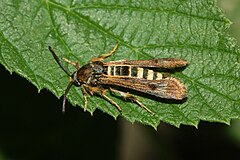|
Pennisetia hylaeiformis
Pennisetia hylaeiformis, the raspberry clearwing, is a moth of the family Sesiidae. Subspecies
DistributionThis species can be found in most of North and Central Europe.[1] It is also present in Caucasus, Transcaspia, Siberia, Manchuria and Japan.[2] DescriptionPennisetia hylaeiformis can reach a wingspan of 22–32 mm.[3] These moths have brown forewings characterized by a narrow transparent wedge shaped area and by a small three-cell outer window. The veins M3 and Cu1 of the hind wings are long stalked. The thorax is black, with a yellow collar and two yellow stripes on mesonotum.[4] In males the abdomen shows four yellow bands of the same width on seg IV to VII, while females have three bands only (on seg IV to VI), with an orange-brown tail. Antennae are cristate and double-crescent-like shaped in males, while in females they are setaceous.[5][6] The caterpillars are whitish and have a black head.
BiologyThe moth flies from June to August depending on the location. The larvae live in stalk and roots of raspberries (Rubus idaeus, Rubus boisseri, Rubus afzeliana, Rubus fruticosus) and feed on their roots.[2][7][8] Parasitoids of the larvae of the raspberry clearwings are various Ichneumonidae and Braconidae species such as Liotryphon punctulatus, Apanteles glomeratus, Lissanota pimplator, Bracon erraticus and Macrocentrus marginator.[2][9] Gallery
ReferencesWikispecies has information related to Pennisetia hylaeiformis. Wikimedia Commons has media related to Pennisetia hylaeiformis.
External links |
||||||||||||||||||||||||||||||||||||





